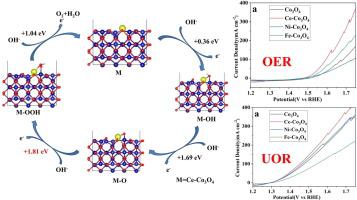Journal of Colloid and Interface Science ( IF 9.4 ) Pub Date : 2022-10-17 , DOI: 10.1016/j.jcis.2022.10.031 Haibin Wang 1 , Xiaoqiang Du 1 , Xiaoshuang Zhang 2 , Lu Li 3

|
Electrocatalytic water splitting has become one of the most promising and effective ways to solve energy crises and environmental pollution. In this work, a series of M-doped Co3O4 materials with foreign ions (M = Ce, Ni and Fe) were grown on a Ni foam substrate through classical hydrothermal and calcination methods. It is worth noting that not all doping of foreign ions can promote the electrocatalytic performance of intrinsic materials. The Ce-doped Co3O4 material shows excellent oxidation properties of water (overpotential of 320 mV at 50 mA cm−2) and urea (potential of 1.39 V at 50 mA cm−2). However, the doping of Ni reduces the water oxidation performance of the intrinsic material (overpotential of 410 mV@ 50 mA cm−2), and the doping of Fe reduces the urea oxidation performance of the inherent material (potential of 1.45 V@ 50 mA cm−2). A series of experimental results indicate that the improved activity of the Ce-Co3O4 electrode is attributed to faster electron transport capacity, higher exposure to active sites, and improved conductivity due to doping of Ce. It is noteworthy that the doping of these ions does alter the rate-determination step for the water oxidation reaction. The stability test demonstrated that the current density of water oxidation and urea oxidation of the catalyst had no significant attenuation after a long electrocatalytic activity test. This work provides a new idea for improving the electrocatalytic activity of catalysts by a doping strategy.
中文翻译:

在泡沫镍上控制合成 M 掺杂的 Co3O4(M = Ce、Ni 和 Fe)作为析氧反应和尿素氧化反应的稳健电催化剂
电催化水分解已成为解决能源危机和环境污染最有希望和最有效的方法之一。在这项工作中,通过经典的水热和煅烧方法在泡沫镍基板上生长了一系列具有外来离子(M = Ce、Ni 和 Fe) 的 M 掺杂 Co 3 O 4材料。 值得注意的是,并非所有外来离子的掺杂都能促进本征材料的电催化性能。 Ce掺杂的Co 3 O 4材料显示出优异的水(在50 mA cm -2时为320 mV的过电势)和尿素(在50 mA cm -2时为1.39 V的电势)的氧化性能。 但是,Ni的掺杂降低了本征材料的水氧化性能(过电位410 mV@50 mA cm -2),Fe的掺杂降低了本征材料的尿素氧化性能(过电位1.45 V@50 mA)厘米-2)。一系列实验结果表明,Ce-Co 3 O 4活性的提高电极归因于更快的电子传输能力,更高的活性位点暴露以及由于掺杂Ce而提高的电导率。值得注意的是,这些离子的掺杂确实改变了水氧化反应的速率确定步骤。稳定性测试表明,经过长时间的电催化活性测试,催化剂的水氧化和尿素氧化电流密度没有明显衰减。该工作为通过掺杂策略提高催化剂的电催化活性提供了新思路。





















































 京公网安备 11010802027423号
京公网安备 11010802027423号